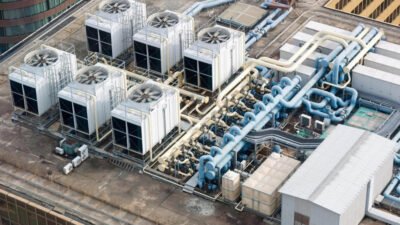Construction projects, regardless of their scale, demand a combination of precision, versatility, and strength. The key to achieving a high level of efficiency on any construction site lies in the utilisation of the right equipment. Among the various machinery options at the disposal of project managers, a crawler crane have become a cornerstone in the sector due to their unique characteristics and the multiple advantages they offer in construction operations.
The Role of Hydraulic Crawler Cranes in Construction
Hydraulic crawler cranes are a specific type of mobile crane designed for lifting heavy loads and transporting them within a construction site. Unlike wheeled cranes, crawler cranes move on tracks, which significantly enhances their stability and allows them to operate on various types of terrain, including soft ground. The hydraulic systems within these cranes provide them with the necessary power to handle substantial weight capacities, making them ideal for major construction projects.
One of the defining attributes of crawler cranes is their capacity to undertake tasks efficiently while maintaining high levels of safety. The hydraulic mechanisms enable smooth operation, precise load handling, and flexibility in movement. This is particularly important in environments where precision is non-negotiable, such as in the installation of large structures or delicate machinery.
Enhancing Productivity with Crawler Cranes
To boost productivity, project managers should focus on the strategic deployment of crawler cranes. These cranes are known for their ability to move with cargo attached, which diminishes the need for reassembly at different locations and thus saves valuable time. Moreover, the design of crawler cranes often includes robust lifting capacities, which enables the completion of tasks that may otherwise require multiple cranes or machines.
The crawler crane’s inherent stability stems from its broad footprint and track-based movement. This aspect not only mitigates the risk of tipping over but also allows crane operators to work in confined spaces that other mobile cranes cannot access. With such an asset on site, teams can manoeuvre around obstacles and reach otherwise inaccessible lifting points.
Choosing the Right Crawler Crane for Your Project
Selecting the appropriate crawler crane for a project is crucial to maximising on-site efficiency. Project managers should consider several factors such as lift capacity, boom length, counterweight configuration, and transportability. The right balance between these elements will ensure that the crane can perform efficiently without causing undue disruption to the rest of the site operations.
Safety is another significant consideration. Modern crawler cranes come with advanced technology and safety features, including wind speed monitors, load moment indicators, and camera systems. These safety implementations not only protect the operators and other site workers but also enhance operational precision.
Advantages of Using Hydraulic Crawler Cranes
Beyond the productivity and safety advantages already mentioned, crawler cranes offer additional benefits. Their tracks provide lower ground pressure which is essential for operating on soft or sensitive surfaces without causing damage. Hydraulic crawler cranes also tend to have a smaller footprint compared to their lifting capability, which enables them to be positioned closer to the load, further enhancing lifting efficiency.
Furthermore, the hydraulic systems used in these cranes allow for smooth acceleration and deceleration during lifts, minimising the risk of load swing and providing greater control over complex lifting tasks. This control is of paramount importance when the margin for error is slim and the consequences of load mismanagement can be severe.
Environmental Considerations and Crawler Cranes
As the construction industry becomes more conscious of its environmental impact, hydraulic crawler cranes are increasingly being designed with eco-friendly considerations. Some models feature energy-efficient engines and systems that reduce emissions without compromising on performance. These advances support the industry’s efforts towards greener construction methodologies.
Another important environmental aspect is the ability to disassemble crawler cranes relatively easily for transport. This scalability reduces the number of transports needed to move the crane to and from a site, thus lessening the carbon footprint associated with logistical arrangements.
Training and Expertise in Crawler Crane Operations
The benefits of crawler cranes are maximised when operators possess the necessary training and expertise. It’s crucial for construction companies to invest in qualified personnel and provide ongoing training. Operators need to understand the intricacies of hydraulic systems and how they relate to the crane’s overall performance. Education in safety protocols is also vital to prevent accidents and ensure smooth operations on site.
Qualified personnel will be adept at planning lifts, understanding load charts, and making the correct judgements regarding placement and movement. This expertise directly translates into a more efficient and safer work environment, which further enhances site productivity.
Streamlining Construction Processes with Crawler Cranes
Ultimately, the integration of crawler cranes into construction processes provides an opportunity to streamline the completion of tasks. They offer adaptability, powerful performance, and precision, which are essential components for modern construction projects. Project managers aiming to maximise efficiency on-site cannot overlook the value that hydraulic crawler cranes bring to the table.
In being strategic about how and where to deploy these machines, taking into account the various specifications that match the project requirements, and ensuring that equipment is operated by competent and qualified professionals, the construction industry can continue to evolve. By utilising crawler cranes effectively, projects can be completed on time, within budget, and with the desired level of quality, thus achieving overall project success.
Conclusion
In summary, the hydraulic crawler crane is an indispensable piece of machinery in the construction industry. From enhancing productivity and ensuring safety to addressing environmental concerns, these cranes play a critical role in the successful execution of construction projects. As technology advances, so too will the capabilities of crawler cranes, making them even more crucial to the efficiency and sustainability of construction operations worldwide.



